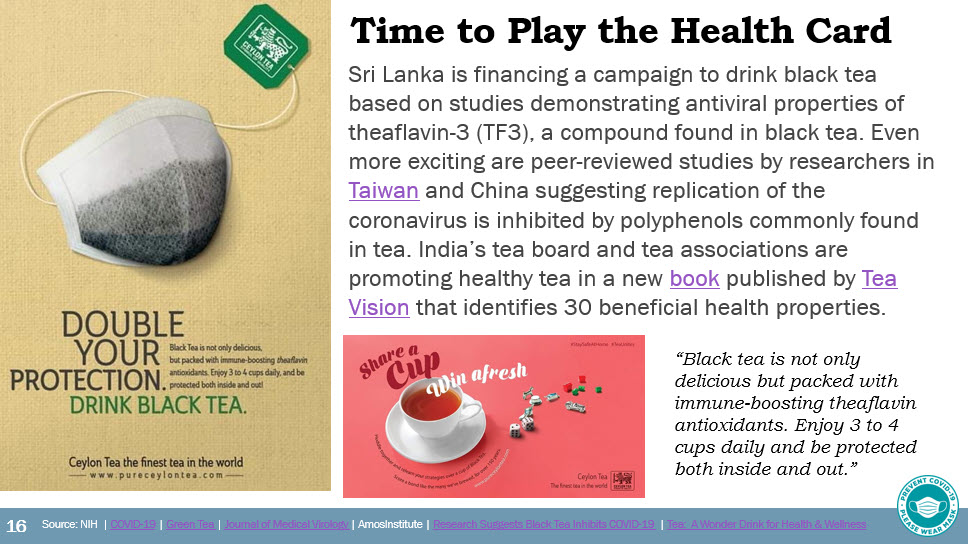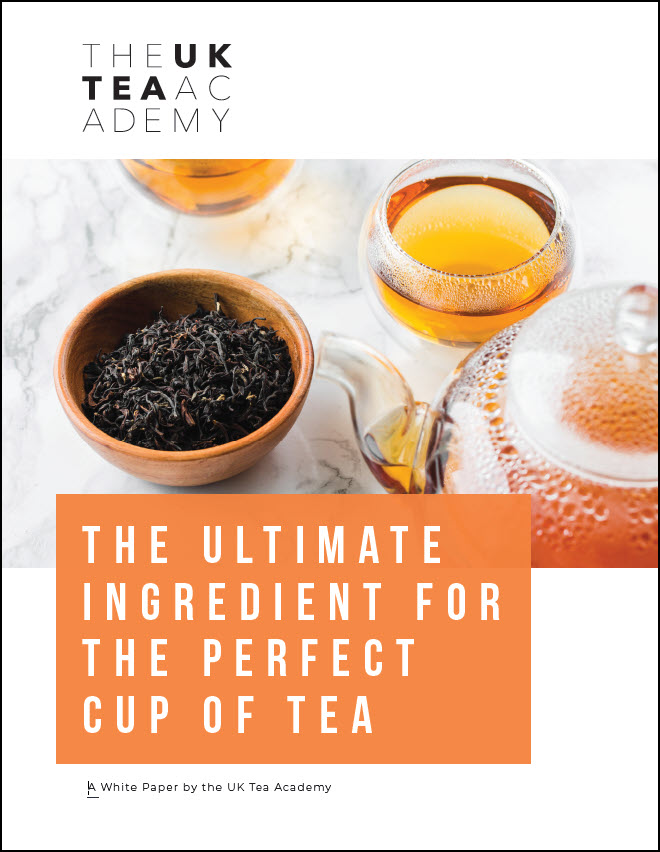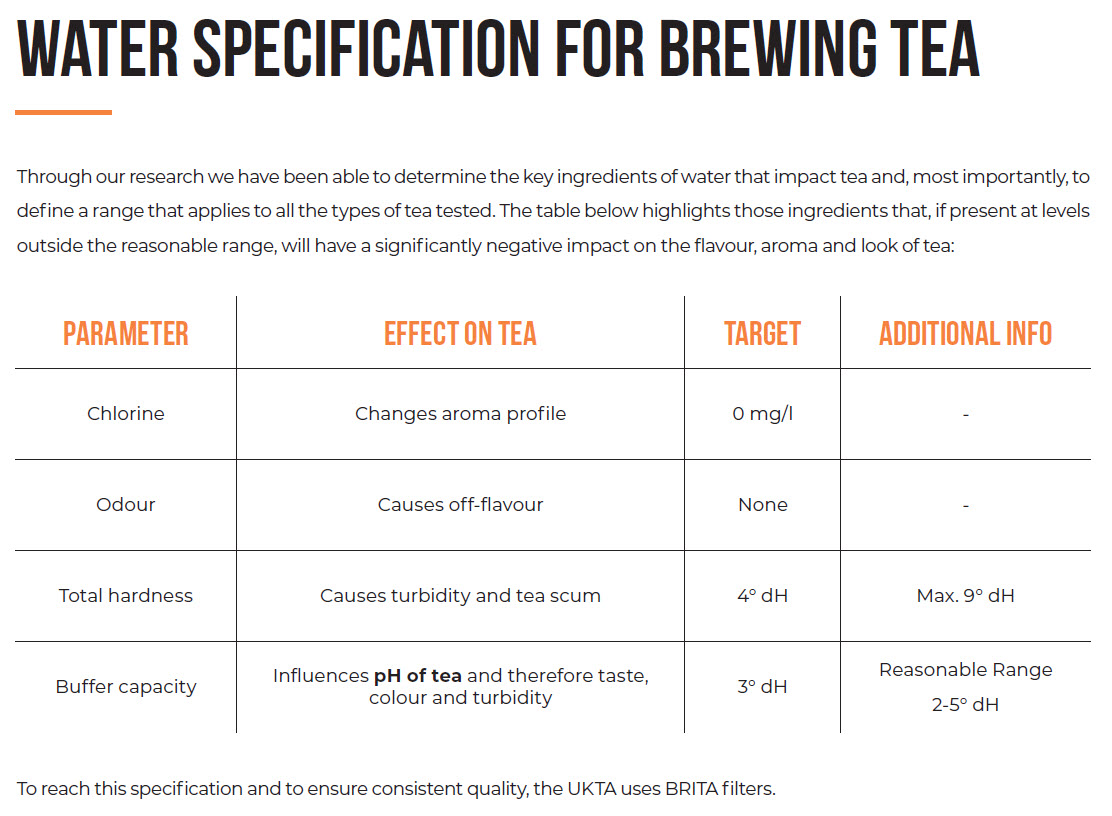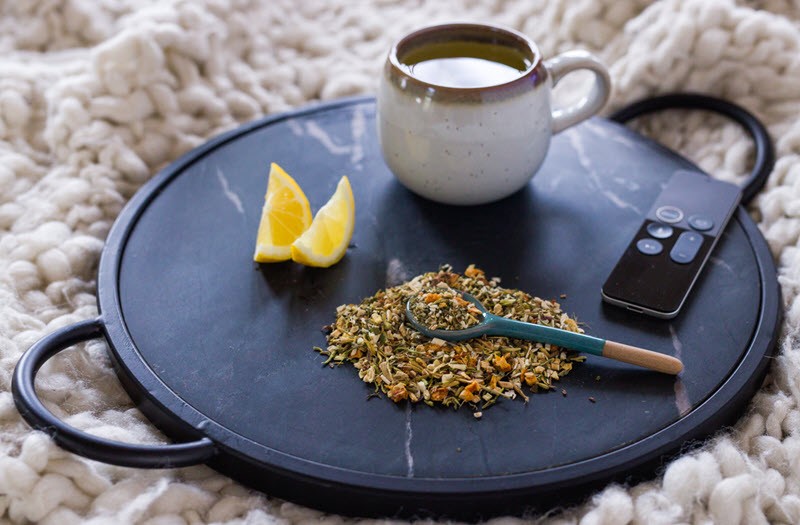Tea Industry News for the week of June 8
- Theaflavins Inhibit Virus Replication
- Immunity is the Epicenter of Health Enhancing Foods
- Water Works Wonders
- Digesting Grubhub
- Tea for the Front Line

“Now is the time to play the health card” I advised during a June 10 webinar on Tea Vulnerabilities hosted by the European Speciality Tea Association (formerly known as The European Tea Society).
Click here to watch a recording of the webinar.
Recent scientific articles* suggest that black tea polyphenols derived during the oxidation of tea catechins could potentially inhibit the ability of the coronavirus to replicate.
RNA replication in the coronavirus is a two-step mechanism that relies on the RdRP (RNA-dependent RNA polymerase) protein to catalyse the synthesis of the RNA strand.
Authors of a March article in the Journal of Medical Virology conclude that “theaflavin could be used as a lead compound for developing a SARS?CoV?2 inhibitor that targets RdRp. However, the exact in vivo effect is still unclear, and further research is needed to confirm the mechanism whereby theaflavin target SARS?CoV?2.”
Medical researchers in Taiwan recently concluded an investigation of 720 compounds listed in the Natural Product Libraries for anti-COVID-19 efficacy. The list was narrowed to 10 compounds and mixtures that had strong potential for anti-COVID-19 efficacy, according to Dr. Bashar Khiatah. “The compounds that have been found to have an anti-COVID 19 effect are the polyphenols that are found in teas,” writes Amylee Amos, MS, RDN. These are found in black tea, green tea, oolong tea, and pu-erh. The most promising is Theaflavin-3,3? -digallate (TF3) which is converted from catechins during fermentation.
Researchers in 1998 found tea theaflavins completely neutralized bovine coronavirus and rotavirus infections. In 2005 Chinese researchers showed that black tea significantly inhibited chymotrypsin-like protease activity essential to virus reproduction. Recent in-vitro studies found TF3 completely inhibited COVID virus replication in cell cultures.
The Indian Council of Medical Research (ICMR) announced that it will study Theaflavins’ antiviral properties.
*View research paper abstracts and links at end of this report.
Immunity is the Epicenter of Health Enhancing Foods
The polyphenols in tea are known to boost immunity and combat inflammation. Health institutes worldwide have for several years recommended eating foods and beverages that reduce inflammation and naturally boost the body’s immune system.
Due to the pandemic this health message has captured the attention of consumers who are increasingly seeking out products to boost their immune system, according to a post-pandemic study by Unilever’s CMI U-Futures and CMI People Data Centre.
Unilever found that in the US the intake of vitamin supplements in March rose by 15% in the space of a month. In Brazil consumers are bingeing on vitamin c-rich fruits and in Japan, yogurt formulated to boost the immune system saw a spike in sales.
Just Food reports that in Israel, interest in immune-system supportive ingredients rose 66% in March. According to AI-focused market research firm Tastewise, “we expect the trend to continue to rise. Immunity, stress relief, medicinal benefits and more are all skyrocketing.”
In China, a post-Covid-19 study of consumer behavior by McKinsey & Co. found that 70% of consumers intend to “work to boost their own physical immunity by exercising more and eating healthy.”
A review of ingredients used by at-home cooks shows a preference for wholesome, lean foods which may be influenced by studies showing obese victims are less likely to survive COVID-19.
“The desire for health and well-being post pandemic is a consistent trend across all markets,”? Unilever concluded. Unilever CEO Alan Jope told analysts “anything that’s in the space of wellness – health and well-being – is going to enjoy sustained strength.”
Having an optimally working immune system is more important than ever. The way our body deals with an infection is influenced by many factors of which the nutritional status is a critical element,”? Dr Angelika De Bree, Unilever’s global nutrition director, explained to the The Food Navigator..
“Our biggest food brands offer thousands of products and recipes which are nutritious, affordable and made with sustainably sourced ingredients,” according to Dr. De Bree.
Tea is clearly the ideal beverage for the situation at hand.
“Our tea and herbal category delivers healthy hydration through Earth’s most sustainable plant-based drinks,” she said.
Water Works Wonders
The UK Tea Academy released a white paper describing “The Ultimate Ingredient for The Perfect Cup of Tea” – that being water.
“Water, which makes up to 99% or more of a cup of tea, is an often-overlooked ingredient that has a huge impact on the taste, aroma, and appearance of every cup. Following research of many different teas and many different waters, this paper finally provides the ideal water specification need to make the best brew,” writes Jane Pettigrew, one of three principal authors of the 12-page report.
The white paper highlights the key ingredients of water which impact the brewing process of tea. It also describes a standard water specification to create the optimal cup of tea.
Click to download the document here.

Water used to brew tea has not been considered in the same way as water for coffee, according to the report.
If the ideal water is not used, the delicate notes of tea cannot be realized, resulting in a bad experience with even the finest of teas. Sadly, this leads to a lack of consumer confidence as well as misconceptions of how certain teas taste.
“A perfect example of this is green tea. It is very common for people to “think” that they do not like green tea, the opinion reached because the tea has been almost certainly made with unfiltered water, at the wrong temperature and over-brewed. The entire flavor profile is altered, often leaving the tea bitter and undrinkable. Brew a green tea correctly and the entire experience is worlds apart in comparison,” writes Pettigrew.
The report delves into the chemistry of water, describes the importance of removing chlorine and preserving the the buffer capacity of the water, a delicate balance of calcium and magnesium that defines ideal “hardness.”
Retailers and tea traders should view this work as an excellent resource and, like those in the coffee world, they should adopt a water standard when tasting tea.
The specification appears below.

Digesting Grubhub
European food delivery venture Just Eat Takeaway derailed what looked like a pre-destined Uber takeover of Grubhub this week.
In May San Francisco-based Uber Technologies was set to acquire Chicago-based Grubhub to become the largest online foodservice delivery firm in the US. Haggling over price, and the likelihood of antitrust scrutiny, killed the deal which was valued at several hundred million (Uber offered $62.50 per share).
In June, Amsterdam-based Just Eat Takeaway offered the equivalent of $75.15 per Grubhub share. Just Eat (UK) and Takeaway (The Netherlands) combined their businesses in April, and now control a huge share of Europe’s growing market for both delivery and food delivery software.
Packaged Facts analyst Cara Rasch said the deal “will allow Just Eat Takeaway to gain a larger footprint in North America, and diversify Grubhub’s business. Skip the Dishes, a subsidiary of Just Eat Takeaway, does a lot of business in Canada and could help the Grubhub brand expand more broadly through North America.”
“In the short-term, third-party restaurant delivery apps have a number of advantages over in-house delivery,” she explains. “They are convenient for consumers because they allow customers to order from a variety of venues using one application. They also can allow smaller businesses without the capital to invest in in-house development of effective online apps to expand their delivery services quickly in the wake of COVID-19, which has forced fast changes,” writes Rasch, but restaurants consider the commissions that third-party online delivery companies charge to be a burden. “If they don’t raise their prices for meals ordered via a third-party app, they are in danger of losing money in an already tight-margin business that has been threatened by lower overall restaurant sales during the pandemic,” she said.

The outlook for carryout and delivery is bright due to distancing guidelines that have shuttered dine-in service or forced restaurants to greatly limit their dine-in capacity.
Long term, “many restaurants are going to see the value of investing in an in-house system for delivery orders. Using a third-party company for ordering and delivery makes it harder for restaurants to develop a direct relationship with consumers. It is also challenging to ensure food quality since restaurants have no control over the food once it leaves the restaurant,” she said.
Source: Packaged Facts, Food-Carryout & Delivery
Tea for the Front Line
The Tea Spot launched its new Flu Fighter tea, a caffeine-free herbal blend that features functional ingredients, including astragalus, honeysuckle, organic licorice root, orange peel, tangerine peel, dandelion root, mulberry leaf, red root and organic ginger.

The ingredients in the new Flu Fighter tea were chosen based on a recent medical report, published in Military Medical Research (Volume 7, Article Number 4, February 2020), on the diagnosis and treatment of the novel coronavirus (2019-nCoV), where a combination of herbs and roots were used to support flu-like symptoms.
According to Maria Uspenski, founder and CEO of The Tea Spot and author of Cancer Hates Tea, many of the natural herbs in this sweet, nourishing tea were also used in ancient times to make wellness broths for recovery and building strength. And while the Flu Fighter tea is meant to be supportive and maintain wellness, it is not meant to treat, cure or prevent any disease or ailment.
“The pain and stress of the current pandemic has pushed The Tea Spot to think outside the box as to how we can help empower people to find and support better overall wellness,” said Uspenski. “The result of our efforts is our aromatic and medicinal Flu Fighter herbal tea, inspired by recent medical research. This supportive tea is intended to be used in combination with social distancing, good personal hygiene, sound diet, ample exercise and rest, while it encourages wellness and facilitates calm amidst the turmoil and uncertainty that’s happening around the world.”
The Tea Spot donates 10% of all profits in-kind to cancer survivors and community wellness programs. In May The Tea Spot donated 55,000 specialty tea sachets to first-responders in New York, California, and Texas.
Footnote: The US Census Bureau on June 8 announced a very helpful online resource for understanding and keeping up with the impact of COVID-19. Visit: COVID-19 Data Hub (https://covid19.census.gov/).
THEAFLAVIN REFERENCES
*Jrhau LungYu?Shih LinYao?Hsu YangYu?Lun ChouLi?Hsin ShuYu?Ching ChengHung Te LiuChing?Yuan Wu |The potential chemical structure of anti?SARS?CoV?2 RNA?dependent RNA polymerase | First published: 13 March 2020 https://doi.org/10.1002/jmv.25761
Chen CN, Lin CP, Huang KK, et al. Inhibition of SARS-CoV 3C-like Protease Activity by Theaflavin-3,3′-digallate (TF3). Evid Based Complement Alternat Med. 2005;2(2):209–215. doi:10.1093/ecam/neh081
Clark KJ, Grant PG, Sarr AB, Belakere JR, Swaggerty CL, Phillips TD, et al. An in vitro study of theaflavins extracted from black tea to neutralize bovine rotavirus and bovine coronavirus infections. Vet Microbiol. 1998;63:147–57.
Ksiazek TG, Erdman D, Goldsmith CS, et al. A novel coronavirus associated with severe acute respiratory syndrome. N Engl J Med. 2003;348(20):1953–1966. doi:10.1056/NEJMoa030781
Hegyi A, Friebe A, Gorbalenya AE, Ziebuhr J. Mutational analysis of the active centre of coronavirus 3C-like proteases. J Gen Virol. 2002;83(Pt 3):581–593. doi:10.1099/0022-1317-83-3-581
Leung WK, To KF, Chan PK, et al. Enteric involvement of severe acute respiratory syndrome-associated coronavirus infection. Gastroenterology. 2003;125(4):1011–1017. doi:10.1016/s0016-5085(03)01215-0
Herold J, Gorbalenya AE, Thiel V, Schelle B, Siddell SG. Proteolytic processing at the amino terminus of human coronavirus 229E gene 1-encoded polyproteins: identification of a papain-like proteinase and its substrate. J Virol. 1998;72(2):910–918.
Muhammad Tahir ul Qamar, Safar M. Alqahtani, Mubarak A. Alamri, Ling-Ling Chen, Structural basis of SARS-CoV-2 3CLpro and anti-COVID-19 drug discovery from medicinal plants†,Journal of Pharmaceutical Analysis,2020,ISSN 2095-1779,https://doi.org/10.1016/j.jpha.2020.03.009.
Zhavoronkov, Alex; Aladinskiy, Vladimir; Zhebrak, Alexander; Zagribelnyy, Bogdan; Terentiev, Victor; Bezrukov, Dmitry S.; et al. (2020): Potential COVID-2019 3C-like Protease Inhibitors Designed Using Generative Deep Learning Approaches. ChemRxiv. Preprint. https://doi.org/10.26434/chemrxiv.11829102.v2
Chen CN, Liang CM, Lai JR, Tsai YJ, Tsay JS, Lin JK. Capillary electrophoretic determination of theanine, caffeine, and catechins in fresh tea leaves and oolong tea and their effects on rat neurosphere adhesion and migration. J Agric Food Chem. 2003;51:7495–503.



One response to “Time to Play the Health Card”
Why has it taken so long for us to see a good article on the virus-fighting capabilities of TEA?